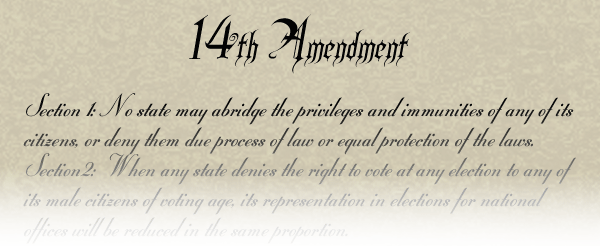Despite reluctantly acceding to the core requirements for readmission to the Union, many of the former Confederate states began passing laws – the so-called "Black Codes" – that disenfranchised the former slaves economically and politically. This drove the Republicans who controlled Congress to undertake stronger measures to impose their will on the defeated Southern states. The first of these came in the form of the 14th Amendment, a more detailed set of restrictions on the states than either of the other Civil War amendments. Its main points are summarized below: Section 1: No state may abridge the privileges and immunities of any of its citizens, or deny them due process of law or equal protection of the laws. Section 2: When any state denies the right to vote at any election to any of its male citizens of voting age, its representation in elections for national offices will be reduced in the same proportion. (Basically, if a state excludes African Americans, then it will be given proportionally fewer seats in the U.S. House of Representatives and fewer votes in the presidential electoral college.) Section 3: No person who has engaged in or supported insurrection or rebellion against the United States may hold public office. Section 4: All debts incurred in aid of insurrection or rebellion against the United States and all compensation claims made for emancipation of any slave will be held as illegal and void. Congress proposed the 14th Amendment on June 13, 1866. More than two years later on July 28, 1868 the U.S. Secretary of State certified that it had been ratified by twenty-eight of the thirty-seven states. In the intervening time, the Congressional elections of 1866 added to the strength of the Republicans, giving them the two-thirds majority in both houses of Congress needed to override any presidential veto. The Republicans began the new session in March 1867 by passing additional reconstruction laws (over President Johnson's veto), inaugurating a new period of much firmer treatment of the South known as the Radical Reconstruction. Congress divided the South into military districts and required the states to adopt new constitutions, provide for black suffrage, and ratify the (still un-ratified) 14th Amendment. Texas had rejected the 14th Amendment on October 27, 1866, but later ratified it – along with the 13th and 15th Amendments – on February 18, 1870 to satisfy the requirements to rejoin the Union. | 







No comments:
Post a Comment